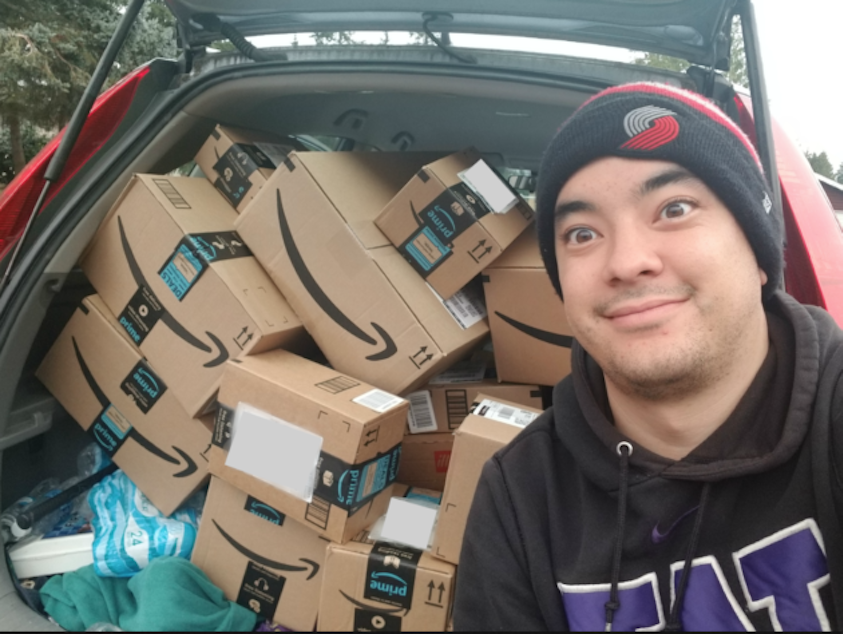I delivered packages for Amazon. Here's what I learned

This week on Prime(d), we talk to GeekWire reporter Taylor Soper about his experience being one of those drivers. Here’s what he told us. Interview edited for clarity.
It was easier than you’d think to be an Amazon driver. It took a background check, a driver’s license submission, watching 20 online videos, and then I was in.
Read Taylor Soper's story on GeekWire.
And just like that, I was delivering packages in Seattle before Christmas. I was basically Santa Claus.
I was paid above minimum wage, probably, but you need to factor in, as you would as an Uber driver, the cost of gas and insurance, and wear and tear on your car.
My first shift was three or four hours and I made $58. That was for delivering three packages. (That pencils out to $19/hour for a three-hour shift, or $14.50/hour for a four-hour shift.)
For that first shift, which was a Sunday evening, I went to a facility in Georgetown south of downtown Seattle. I found the facility and drove up to see a line of cars waiting to get into a big warehouse. As I waited my turn, moving in line slowly, everyone eventually drove in and stopped their car.
I saw Amazon workers walking around, and eventually, they walked over to scan my phone app to find out who I was. The app also tells them which packages go to me.
After I was scanned in, someone rolled over three packages to be delivered in the Bellevue area. I was like, ‘Cool! Only three packages.’ Except one of them was this giant mirror, and it barely fit into my Honda CR-V. I wondered, how would someone who wasn't as fit be expected to carry this?
The big mirror was delivered to a giant mansion up in the hills. I finally got to the place, lugged it up some stairs to the door, started sweating, and then I was breathing heavily after. But I got it there safely.
My next experience was much different. This time, I went to a facility in north Seattle. When I got there, an Amazon worker wheeled out a trolley, lifted up a blanket, and there were 41 packages. I was like, ‘Wait, only half or a quarter of these must be for me.’ But they were all for me. Based on their math, that’s normal for a three-hour shift.
You don't know what you'll be delivering when you sign up for a shift. You don’t know until you get to Amazon’s facility. You just know where you’re going and the general area. Amazon tries to put all the deliveries into one area, so you’re not driving all over the place.
I had prepped by watching some YouTube videos of people explaining how to do this job, but I was disappointed that there wasn’t much as far as tips and advice from Amazon in terms of how to strategically manage the deliveries.
When you pour 41 packages in your car, you don’t know which one’s first and which one’s last, and then when you get to a house, you’re just kind of digging through and looking at the labels. I didn’t know what I was doing.
A lot more labor went into that second experience – maybe less driving, but it took more time and more effort.
When you refresh the Flex app, Amazon is also changing the price of what the job is worth. It seems that Amazon's algorithm is calculating every few minutes what demand they need and how many drivers they'll need out delivering packages.
I did this right before Christmas, and I was getting a lot of e-mails saying they needed more drivers. So I think the pay may have been more at that time.
Most of the customers were suspicious. I was wearing a hoodie, sweatpants, and a winter hat – I was just a random guy coming out of my car with a package – so that was weird. But it was also kind of fun from a customer service perspective, bringing holiday cheer.
My personal concerns were: Do I leave my car on? Where do I park my car? I have 40 packages in the back of my car, what if someone steals them? Would Amazon get mad at me?
There are intricate things you don’t think about when signing up for the job. It wasn’t only physical stress, but also mental stress.
I expected a bunch of young people like myself to be doing it but it was older folks – parents – a lot of different people.
If you want to drive around the city and not have to pick up or drop off anyone, this is probably better than an Uber or a Lyft. But overall, it depends on where you're at with your life and your budget.
Sponsored
Listen to the podcast by clicking the play button above or wherever you get your podcasts.
Our theme song is "Ripples on an Evaporated Lake" by Raymond Scott.
Produced for the web by Brie Ripley and Isolde Raftery.




